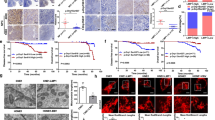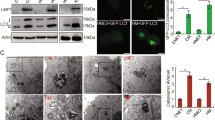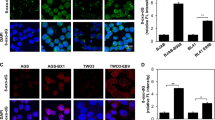Abstract
The latent membrane protein (LMP1) encoded by Epstein–Barr virus (EBV) has been suggested to be one of the major oncogenic factors in EBV-mediated carcinogenesis. RNA-cleaving DNA enzymes are catalytic nucleic acids that bind and cleave a target RNA in a highly sequence-specific manner. In this study, we explore the potential of using DNAzymes as a therapeutic approach to EBV-associated carcinomas by targeting the LMP1 gene. In all, 13 different phosphorothioate-modified “10–23” deoxyribozymes (DNAzymes) were designed and synthesized against the LMP1 mRNA and transfected into B95-8 cells, which constitutively express the LMP1. Fluorescence microscopy was used to examine the cellular uptake and distribution in B95-8 cells. As demonstrated in Western blots, three out of 13 deoxyribozymes significantly downregulated the expression of LMP1 in B95-8 cells. These DNAzymes were shown to markedly inhibit B95-8 cell growth compared with a disabled DNAzyme and untreated controls, as determined by an alamarBlue Assay. It was further demonstrated that these DNAzymes arrested the B95-8 cells in G0/G1 using flow cytometry. Interestingly, the active DNAzymes could also downregulate the expression of Bcl-2 gene in treated cells, suggesting a close association between the LMP1 and Bcl-2 genes and their involvement in apoptosis. This was further confirmed with the result that the DNAzymes could induce the release of cytochrome c from mitochondria, which is the hallmark of the apoptosis. The present results suggest that the LMP1 may present a potential target for DNAzymes towards the EBV-associated carcinoma through cell proliferation and apoptosis pathways.
This is a preview of subscription content, access via your institution
Access options
Subscribe to this journal
Receive 12 print issues and online access
$259.00 per year
only $21.58 per issue
Buy this article
- Purchase on Springer Link
- Instant access to full article PDF
Prices may be subject to local taxes which are calculated during checkout






Similar content being viewed by others
References
Epstein MA, Acjpmg BG, Barr YM, Zajac B, Henle G, Henle W . Morphological and virological investigation in cultured Burkitt tumor lymphoblasts (strain Raji). J Natl Cancer Inst. 1966;333:693–698.
Rickinson AB . Epstein–Barr virus in action in vivo. N Engl J Med. 1998;338:1461–1463.
Grinstein S, Preciado MV, Gattuso P, et al. Demonstration of Epstein–Barr virus in carcinomas of various sites. Cancer Res. 2002;62:4876–4878.
Eliopoulos AG, Young LS . Activation of the c-Jun N-terminal kinase (JNK) pathway by the Epstein–Barr virus-encoded latent membrane protein 1 (LMP1). Oncogene. 1998;16:1731–1742.
Eliopoulos AG, Young LS . LMP1 structure and signal transduction. Semin Cancer Biol. 2001;11:435–444.
Hatzivassiliou E, Mosialos G . Cellular signaling pathways engaged by the Epstein–Barr virus transforming protein lmp1. Front Biosci. 2002;7:D319–D329.
Gires O, Kohlhuber F, Kilger E, et al. Latent membrane protein 1 of Epstein–Barr virus interacts with JAK3 and activates STAT proteins. EMBO J. 1999;18:3064–3073.
Tsao SW, Tramoutanis G, Dawson CW, Lo AK, Huang DP . The significance of LMP1 expression in nasopharyngeal carcinoma. Semin Cancer Biol. 2002;12:473–487.
Scherer LJ, Rossi JJ . Approaches for the sequence-specific knockdown of mRNA. Nat Biotechnol. 2003;21:1457–1465.
Sun LQ, Cairns MJ, Saravolac EG, Baker A, Gerlach WL . Catalytic nucleic acids: from lab to applications. Pharmacol Rev. 2000;52:325–347.
Santoro SW, Joyce GF . A general purpose RNA-cleaving DNA enzyme. Proc Natl Acad Sci USA. 1997;94:4262–4266.
Santiago FS, Lowe HC, Kavurma MM, et al. New DNA enzyme targeting Egr-1 mRNA inhibits vascular smooth muscle proliferation and regrowth factor injury. Nat Med. 1999;5:1264–1269.
Fahmy RG, Dass CR, Chesterman CN . Transcription factor Egr-1 supports FGFdependent angiogenesis during neovascularization and tumor growth. Nat Med. 2003;9:1026–1032.
Lowe HC, Chesterman CN, Khachigian LM . Catalytic antisense DNA molecules targeting Egr-1 inhibit neointima formation following permanent ligation of rat common cartoid arteries. Thromb Haemost. 2002;87:134–140.
Zhang L, Gasper WJ, Stass SA, Ioffe OB, Davis MA, Mixson AJ . Angiogenic inhibition mediated by a DNAzyme that targets vascular endothelial growth factor receptor 2. Cancer Res. 2002;62:5463–5469.
Mitchell A, Dass CR, Sun LQ, Khachigian LM . Inhibition of human breast carcinoma proliferation, migration, chemoinvasion and solid tumour growth by DNAzymes targeting the zinc finger transcription factor EGR-1. Nucleic Acids Res. 2004;32:3065–3069.
Zhang G, Dass CR, Sumithran E, Girolamo ND, Sun LQ, Khachigian LM . Effect of deoxyribozymes targeting c-Jun on solid tumor growth and angiogenesis in rodents. J Natl Cancer Inst. 2004;96:683–696.
Fielding CA, Sandvej K, Mehl A, Brennan P, Jones M, Rowe M . Epstein–Barr virus LMP-1 natural sequence variants differ in their potential to activate cellular signaling pathways. J Virol. 2001;75:9129–9141.
Cairns MJ, King A, Sun LQ . Optimisation of the 10–23 DNAzyme–substrate pairing interactions enhanced RNA cleavage activity at purine-cytosine target sites. Nucleic Acids Res. 2003;31:2883–2889.
Benimetskaya L, Takle GB, Vilenchik M, Lebedeva I, Miller P, Stein CA . Cationic porphyrins: novel delivery vehicles for antisense oligodeoxynucleotides. Nucleic Acids Res. 1998;26:5310–5317.
Pichon C, Monsigny M, Roche AC . Intracellular localization of oligonucleotides: influence of fixative protocols. Antisense Nucleic Acid Drug Dev. 1999;9:89–93.
Nunamaker EA, Zhang HY, Shirasawa Y, Benoit JN, Dean DA . Electroporation-mediated delivery of catalytic oligodeoxynucleotides for manipulation of vascular gene expression. Am J Physiol Heart Circ Physiol. 2003;285:H2240–H2247.
Dass CR, Saravolac EG, Li Y, Sun LQ . Cellular uptake, distribution, and stability of 10–23 deoxyribozymes. Antisense Nucleic Acid Drug Dev. 2002;12:289–299.
Cairns MJ, Hopkins TM, Witherington C, Wang L, Sun LQ . Target site selection for an RNA-cleaving catalytic DNA. Nat Biotechnol. 1999;17:480–486.
Kaye KM, Izumi KM, Li H, et al. An Epstein–Barr virus that expresses only the first 231 LMP1 amino acids efficiently initiates primary B lymphocyte growth transformation. J Virol. 1999;73:10525–10530.
Dawson CW, Eliopoulos AG, Blake SM, Barker R, Young LS . Identification of functional differences between prototype Epstein–Barr virus-encoded LMP1 and a nasopharyngeal carcinoma derived LMP1 in human epithelial cells. Virology. 2000;272:204–217.
Tao YG, Tan YN, Liu YP, et al. Nuclear factor kappa B (NF-κB) dependent modulation of Epstein–Barr virus latent membrane protein 1 (LMP1) in epidermal growth factor receptor (EGFR) promoter activity. Virus Res. 2004;104:61–70.
Komano J, Sugiura M, Takada K . Epstein–Barr virus contributes to the malignant phenotype and to apoptosis resistance in Burkitt's lymphoma cell line Akata. J Virol. 1998;72:9150–9156.
Abdulkarim B, Sabri S, Zelenika D, et al. Antiviral agent cidofovir decreases Epstein–Barr virus (EBV) oncoproteins and enhances the radiosensitivity in EBV-related malignancies. Oncogene. 2003;17:2260–2271.
Yoshizaki T, Sato H, Furukuwa M, Pagano JS . The expression of matrix metalloproteinase 9 is enhanced by Epstein–Barr virus latent membrane protein 1. Proc Natl Acad Sci USA. 1998;95:3621–3626.
Baldwin AS . The NF-kB and IkB proteins: new discoveries and insights. Annu Rev Immunol. 1996;14:649–681.
Acknowledgements
This research was supported by the National Natural Science Foundation of China for Distinguished Young Scholars (No. 39525022), State Key Research Program, Fundamental Investigation on Human Carcinogenesis of China (No. G1998051201), and the National Natural Science Foundation of China (No. 30200009).
Author information
Authors and Affiliations
Corresponding authors
Rights and permissions
About this article
Cite this article
Lu, ZX., Ye, M., Yan, GR. et al. Effect of EBV LMP1 targeted DNAzymes on cell proliferation and apoptosis. Cancer Gene Ther 12, 647–654 (2005). https://doi.org/10.1038/sj.cgt.7700833
Received:
Published:
Issue Date:
DOI: https://doi.org/10.1038/sj.cgt.7700833
Keywords
This article is cited by
-
Targeting the signaling in Epstein–Barr virus-associated diseases: mechanism, regulation, and clinical study
Signal Transduction and Targeted Therapy (2021)
-
B1.12: a novel peptide interacting with the extracellular loop of the EBV oncoprotein LMP1
Scientific Reports (2019)
-
EBV based cancer prevention and therapy in nasopharyngeal carcinoma
npj Precision Oncology (2017)
-
Co-infection of Epstein-Barr virus and human papillomavirus in human tumorigenesis
Chinese Journal of Cancer (2016)
-
DCE-MRI assessment of the effect of Epstein-Barr virus-encoded latent membrane protein-1 targeted DNAzyme on tumor vasculature in patients with nasopharyngeal carcinomas
BMC Cancer (2014)



